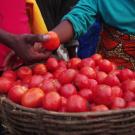This fact sheet describes and depicts information on maturity indices, quality, and harvest for green bananas, or cooking bananas. This document was created as part of the Horticulture Innovation Lab project focused on reducing postharvest loss in Rwanda.
Maturity Indices
There are two stages of maturity for green bananas. Harvest takes place in the second stage. During the first stage the fruit has an angular shape, with an average length of 18 cm, an average circumference of 15.5 cm, and an average weight of 480 grams. In the second stage the sides of the banana become rounded, and the banana increase in size to a length to an average of 24 cm, a circumference of 16.5 cm, and an average weight of 525 grams. In both stages the banana will have a dark green color.
Abscission of the banana when the bunch matures is characterized by the drying of the top most leaf. Premature abscission occurs as a result of damage, low temperature, drought, and other unfavorable conditions.
Quality
High quality green bananas have minimum defects. Bananas which show insect damage should be rejected. Additional quality defects include decay, cracks, and sunburn. Decay is caused by bacteria, yeast, and fungi while cracks are a sign of insufficient nutrients in the peel of the fruit.
Banana harvesting
Bananas should be harvested by hand using a two-person team. One person cuts the bunch stem with a cutting knife and the other carries the bunch away. Using a ladder and a container can help avoid damaging the banana bunch.

